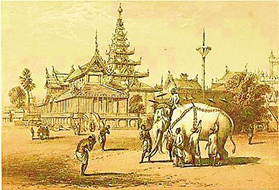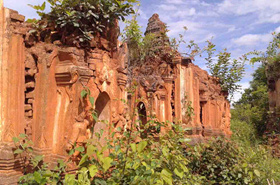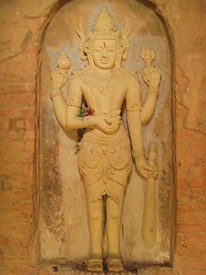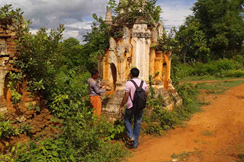Heritage of Myanmar
People & Culture

People and Religion
Across the country, there are over 135 ethnic groups living together. The characteristics of the culture, customs and personalities have blended to create a colourful nation. Multiculturalism is one major aspect of Myanmar’s over-50 million people with the major ethnic group the Bamar making up about 70% of the populace. The remaining seven ethnic groups are mainly divided by geographical regions.
Burmese is the official language, while English is commonly taught in schools and widely used socially In major cities, Chinese and Hindu are the other major linguistic influences. More than 90% of the population in Myanmar are Buddhist. Hinduism, Christianity and Muslim are the other notable minority groups. There is even an old synagogue in Yangon emblematic of the once thriving Hebrew community. Religious freedom is now highly respected in Myanmar.

Trade and Culture
Myanmar is an agricultural country, known as the "Rice Bowl of Asia". Rice is the main food and the most important agricultural export of the country. Teakwood and other wood products are also strong economic operators in Myanmar, thanks to a large forest area. The mining industry for diamonds and precious gems along with rare-earth metals, oil and gas have developed very strongly and contributed significantly to the economic development of the nation.
In the Colonial period, the cultures of China and India had a large impact on Myanmar's traditional cuisine. It has blended creatively but still kept very innovative features of this country’s peculiarities. That is the reason why Burmese cuisine still has many unique aspects of the traditional dishes.
Myanmar's culture, like its food, was also heavily influenced from India, especially reflected in local traditions. This can be seen in the architecture of most stupas and various temples which are very similar to those in southern India.
History
While both the names Bama and Myanma historically referred only to the main ethnic Burmese group, the Burmese governments in the post-independence period instituted a difference in meaning between Myanmar and Bamar in the official Burmese language. The name Myanma/Myanmar was expanded to include all citizens of the country, while the name Bama/Bamar kept its original meaning, referring to the Burmese people. Both are in widespread use colloquially. Most people still use Bamar/Myanmar interchangeably to refer to the country, depending on the context. But officially the country is now called Myanmar.
 As the history of Myanmar is quite complex, we have only noted here the key historical dates.
As the history of Myanmar is quite complex, we have only noted here the key historical dates.
The earliest archaeological evidence of civilization in the Irrawaddy valley dates to about 1500 BC. People in the region were turning copper into bronze, growing rice, and domesticating chickens and pigs; they were among the first people in the world to do so. By 500 BCE, iron-working settlements emerged in an area south of present-day Mandalay. Bronze-decorated coffins and burial sites filled with earthenware remains have been excavated. Archaeological evidence at Samon Valley south of Mandalay suggests rice-growing settlements that traded with China between 500 BC and 200 CE.
 Early civilization in Myanmar dates back to the 1st century with archaeological evidence of Pyu (a Tibetan ethnic group) Kingdoms in Thayekhittaya (Sri Ksetra), Beithano (Visnu) and Hanlin. As early as the 6th century, people called the Mon began to enter from the Mon kingdoms of Haribhunjaya and Dvaravati in modern-day Myanmar. By the mid 9th century, the Mon had founded at least two small kingdoms (or large city-states) centred around Pegu and Thaton.
Early civilization in Myanmar dates back to the 1st century with archaeological evidence of Pyu (a Tibetan ethnic group) Kingdoms in Thayekhittaya (Sri Ksetra), Beithano (Visnu) and Hanlin. As early as the 6th century, people called the Mon began to enter from the Mon kingdoms of Haribhunjaya and Dvaravati in modern-day Myanmar. By the mid 9th century, the Mon had founded at least two small kingdoms (or large city-states) centred around Pegu and Thaton.
In the 11th Century, the First Empire was founded by King Anawrahta as the Bagan Empire, which lasted until the late 13th century when the Mongols invaded them. After the fall of Bagan, the Mongols left the hot Irrawaddy valley but the Kingdom was irreparably broken up into several small kingdoms.
 By the mid-14th century, the country had become organised along four major power centres: Upper Myanmar, Lower Myanmar, the Shan States and Arakan. There were the Ava Kingdom (1364–1555), the Hanthawaddy Pegu Kingdom (1287–1539) founded by King Bayintnaung, the Shan States (1287–1557) and the Arakan (1287–1784). Hanthawaddy was the most powerful and prosperous kingdom of all post-Pagan kingdoms. Under a string of gifted monarchs, the kingdom enjoyed a long golden age, profiting from foreign commerce. The kingdom, with a flourishing Mon language and culture, became a center of commerce and Theravada Buddhism.
By the mid-14th century, the country had become organised along four major power centres: Upper Myanmar, Lower Myanmar, the Shan States and Arakan. There were the Ava Kingdom (1364–1555), the Hanthawaddy Pegu Kingdom (1287–1539) founded by King Bayintnaung, the Shan States (1287–1557) and the Arakan (1287–1784). Hanthawaddy was the most powerful and prosperous kingdom of all post-Pagan kingdoms. Under a string of gifted monarchs, the kingdom enjoyed a long golden age, profiting from foreign commerce. The kingdom, with a flourishing Mon language and culture, became a center of commerce and Theravada Buddhism.
The Toungoo Dynasty (1486–1752)
Toungoo, led by its ambitious king Tabinshwehti and General Bayinnaung, reunified the small kingdoms that had existed since the fall of the Bagan Empire, and founded the largest empire in the history of Southeast Asia. However the overextended empire unravelled soon after Bayinnaung’s death in 1581. Siam declared independence in 1584 and went to war with Burma until 1605. Bayinnaung’s son, Nyaungyan, immediately began the reunification effort, successfully restoring central authority over Upper Burma and Shan States by 1605. Except for a few occasional rebellions and an external war – Burma defeated Siam’s attempt to take Lan Na and Martaban in 1662–64 – the kingdom was largely at peace for the rest of the 17th century. The kingdom entered a gradual decline, and the authority of the “palace kings” deteriorated rapidly in the 1720s.
 The Konbaung Dynasty (1752–1885) was founded by king Alaungpaya.
The Konbaung Dynasty (1752–1885) was founded by king Alaungpaya.
In 1885 the British captured the country to develop its empire. They give Burma full independence in 1948. The military took over power in 1962. Now the succeeding decades were plagued by a series of coups and Socialism isolated Burma/Myanmar from the modern world. With the lifting of international sanctions in 2012 and successful democratic elections, Myanmar (traditionally renamed) is moving toward a viable future. Now would be a propitious time to explore the country along its’ main river, the majestic Ayeyarwady River.











